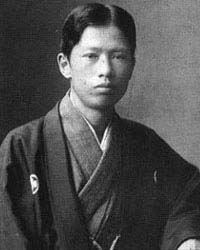- Hishida Shunsō
Infobox Artist
name = Hishida Shunsō

imagesize = 180px
caption = Hishida Shunsō
birthname = Hishida Miyoji
birthdate =21 September 1874
location =Nihonbashi ,Tokyo ,Japan
deathdate =16 September 1911
deathplace =
nationality = Japanese
field = Painter
training =
movement =Nihonga
works =
patrons =
awards =Order of Culture nihongo|Hishida Shunsō|菱田春草|Hishida Shunsō|extra=21 September 1874 -16 September 1911 was the pseudonym of aJapan ese painter from theMeiji period . One ofOkakura Tenshin 's pupils along withYokoyama Taikan andShimomura Kanzan , he played a role in the Meiji era innovation of "Nihonga ". His real name was Hishida Miyoji. He was also known for his numerous paintings ofcat s.Early life
Shunsō was born in 1874 in what is now part of Iida city in
Nagano prefecture . In 1889 he moved toTokyo to study underKano school artist Yuki Masaaki (1834-1904). The following year, he enrolled at the "Tokyo Bijutsu Gakko" (the forerunner of theTokyo National University of Fine Arts and Music ). Shunso was one year junior to his colleaguesYokoyama Taikan andShimomura Kanzan ; his teacher wasHashimoto Gaho . Shunso, Taikan and Kanzan were heavily influenced byOkakura Tenshin andErnest Fenollosa during their time at the "Tokyo Bijutsu Gakko".Artistic career
After graduation, Shunsō was commissioned by the Imperial Household Museum (now the
Tokyo National Museum ) to copy important religious paintings at Buddhist temples inKyoto and Nara, and he also became a teacher at the "Tokyo Bijutsu Gakko". In 1898, he joined Okakura Tenshin in establishing the "Nihon Bujutsuin" (Japan Fine Arts Academy ). From 1903-1905, he traveled extensively overseas, holding exhibitions of his works inIndia , theUnited States and inEurope .After his return to Japan, Shunsō successfully competed in many national exhibitions in Japan, including the government-sponsored "
Bunten ."Shunsō developed a new painting method, derogatorily named by his contemporaries as "moro-tai" (vague style). This new method used a gradation of colors to replace the line drawings that characterized traditional Japanese-style painting. This new style, however, gained little support from Shunsō's contemporaries and was severely criticized by
art critic s. Shunso came to realize that while "moro-tai" was effective in depicting such scenes as morning mist and evening glow, its color gradation technique proved good only for those limited motifs. Shunsō began integrating his original "moro-tai" with line drawing to overcome this disadvantage, and his later works exhibit a new style which came to typify the "Nihonga" genre, distinguishing it from the more restrictive styles of traditional Japanese-style painting.In his final years, Shunsō concurrently suffered from retinal and
kidney disease . Driven by fear of blindness, Shunsō painted frantically whenever his illness entered a state of remission. In 1909, his work "Ochiba" won the highest award at the third "Bunten " Exhibition. It is now designated anImportant Cultural Property and now in the collection of theEisei Bunko Museum , Tokyo. His work "Black Cat" (1910) has also been designated an Important Cultural Property.Philately
One of Hishida Shunsō's works has been selected as the subject of a
commemorative postage stamp s by the Japanese government:* 1979: "Black Cat", as part of the Modern Art Series
In the year 1951, Hishida Shunsō himself was the subject of a commemorative postage stamp under the Cultural Leaders Series by Japan Post.
Famous works
* 寡婦と孤児 (1895, Tokyo National University of Fine Arts and Music)
*水鏡 (1897, Tokyo National University of Fine Arts and Music)
*菊慈童 (1900, Iida Municipal Exhibition Hall)
*雪後の月 (1902, Museum of Modern Art, Shiga)
*王昭君 (1902, Yamagata 善寶寺, Important Cultural Property)
*賢首菩薩 (1907,Tokyo National Museum of Modern Art , Important Cultural Property)
*落葉 (1909, property of Eisei Bunko, entrusted to Kumamoto Prefectural Art Museum, Important Cultural Property)
*黒き猫 (1910, property of Eisei Bunko, entrusted to Kumamoto Prefectural Art Museum, Important Cultural Property)References
* Briessen, Fritz van. "The Way of the Brush: Painting Techniques of China and Japan". Tuttle (1999). ISBN 0804831947
* Conant, Ellen P., Rimer, J. Thomas, Owyoung, Stephen. "Nihonga: Transcending the Past: Japanese-Style Painting, 1868-1968". Weatherhill (1996). ISBN 0834803631External links
* [http://www.lingnanart.com/J-master/J-master-shunso.htm Art site with samples of his works]
* [http://www2j.biglobe.ne.jp/~mkshp/syunso/syunso.html bio site in Japanese with photos and samples of his works]
* [http://iida-museum.org/exhibit_course/shunsou.html Iida Museum site with samples of his works]
* [http://www.chitralekha.org/yokoyama.htm An Artist Remembered by Satyasri Ukil]
* [http://www.chitralekha.org/indianart.htm Which Way Indian Art? by Mukul Dey]
Wikimedia Foundation. 2010.
